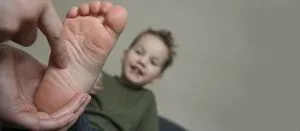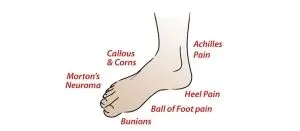Feet: how to care for your feet
Foot problems include athlete’s foot, plantar warts (verrucae), corns, smelly feet and infected toenails.
- Athlete’s foot is a fungal infection — also called tinea pedis. It is contagious via direct contact, wet floors and shared footwear.
- Plantar warts (verrucae) are flat warts in the sole of the foot. They are forced under the skin and may occur in clusters. The surface is greyish and crumbly, and they may contain small black points that are swollen blood vessels. Plantar warts are also contagious via wet floors. Like other warts, they will disappear on their own, but this may take up to 2 years.
- Corns are areas of hard skin that build up on parts of the foot that are subject to pressure or friction, such as on the little toe.
- Smelly feet are usually caused by excessive perspiration and an over-growth of fungi and/or bacteria.
- Infected toenails are commonly the result of a fungal infection, a condition known as onychomycosis. Toenails affected by onychomycosis are often brittle, discoloured or yellow.
What can you do to care for your feet?
Here are several steps you can take towards healthy feet.
- Wear thongs in public showers such as in camping grounds and gyms to help prevent you from contracting athlete’s foot.
- Wash your feet twice daily and dry them thoroughly, particularly between your toes. Use a clean towel.
- Change your socks daily and wear cotton, not synthetic, socks.
- Wash your socks and towels at a high temperature (hot cycle on washing machine).
- Wear well-fitting leather shoes that allow your feet to ‘breathe’ (synthetic shoes tend to increase the amount of perspiration) or wear open shoes or sandals to allow air to circulate freely.
- Bleach your shower/bath area.
- When applying corn or wart medication, make sure it does not get on the healthy, unaffected skin.
When should you seek medical advice?
All of the above conditions can be treated: some by medications that are available from pharmacists, while others, particularly fungal nail infections, can require prescription medication from your doctor. You should also seek medical advice if:
- you suffer from diabetes, as you may lack some feeling in your feet and that can lead to complications such as ulcers;
- you are elderly, as you may have poor circulation;
- you have a mole or dark-coloured spot on your foot;
- there is bleeding.
Feet: checklist for foot health
Here is a list of quick questions to help you check the health of your feet.
- Do you have pain in your feet?
- Are you on your feet all day?
- Do you have skin or nail problems (ingrown or discoloured toenails, corns, skin rashes, areas of hard skin) on your feet?
- Do you have any sores on your feet that are not healing?
- Do you have foot odour?
- Do you have a foot injury?
- Do you have health problems such as diabetes or arthritis?
- Do you have numbness, tingling or burning in your feet?
- Do your feet have poor circulation - are they unusually pale, blue or red?
- Do you trip or fall often?
- Do you have problems finding shoes that fit comfortably?
- Do you have lumps or bumps, bunions or misshapen toes?
- Do you regularly wear heels that are 5 cm (2 inches) or higher?
- If you have answered ‘yes’ to any of these questions, see a podiatrist or your doctor for diagnosis and treatment.
Diabetic conditions affecting the legs and feet
Diabetic conditions affecting the legs and feet
The feet and legs are common sites for complications in people with diabetes mellitus and for this reason good foot care is very important. An injury to the foot or leg can be painful, but in people suffering from diabetic neuropathy (nerve damage) the sensations are dulled and minor injuries often go undetected and untreated, potentially leading to more serious damage.
Loss of temperature sensation is also a significant risk factor for injury in people with diabetes. This can result in a person being unaware that the bath water they are stepping into is scalding them. They may also be at risk of developing severe burns after sitting too close to a heater.
Special attention is needed to prevent circulatory disorders and infections that commonly occur in the lower extremities of people with diabetes. Areas with poor circulation heal badly and, if left unattended, such injuries may develop into ulcers or even become gangrenous.
Do not ignore pain in the feet or legs as this may indicate a problem. Corn plasters should not be used as they may cause foot ulcers.
Good foot care
Good foot care is vitally important for people with diabetes. Every day, wash your feet in warm (not hot) water. If you notice a callus forming, you can try to gently remove it (for example, with a pumice stone). However, once formed, calluses should only be treated by professionals. After washing, apply a moisturiser to your feet, but avoid moisturising between your toes. When you cut your toenails, cut straight across and file down any sharp edges.
Always wear shoes and socks, and choose your shoes carefully. Shoes should be large enough to be comfortable, but not large enough to be slipping off. They should have resilient (but not soft) insoles, and be smooth on the inside, with no rough areas.
Check your feet each night, looking for:
-
dry, scaly, red, itching or cracked skin;
-
areas where something has been rubbing on your feet;
-
blisters;
-
cuts or abrasions;
-
corns or calluses;
-
infections;
-
thickened or discoloured nails;
-
blueness or any swelling; and
-
any red, hot or swollen areas.
If your vision is poor, get someone to check for you.
Any breaks in the skin need to be treated straight away, so see your doctor or podiatrist. Also, try to work out what might have caused the problem so that you can prevent it happening again. If one of your feet is hot and swollen, check it again the next day — see your doctor if it remains hot and swollen.
Your feet should also be examined regularly by a doctor, diabetes specialist or podiatrist. Your doctor or podiatrist can advise you on foot care and also on the selection of appropriate footwear.
Corns and calluses
Corns and calluses
Painful areas on the feet can be a great source of misery, making walking uncomfortable. Sufferers are often reluctant to take regular exercise.
Among the most common causes of sore feet are calluses and corns. These are raised areas of local thickening of the surface layer of the skin. This layer is known as the keratin layer. When it becomes thickened the condition is known as hyperkeratosis.
Calluses and corns are usually found in places where there is friction or pressure. They are usually the result of badly fitting shoes, but can also occur if your feet are abnormally shaped. They are sometimes found on other parts of the body where friction occurs, for example, on the fingers of guitar players.
Calluses are bigger than corns and are usually found on the bottom (sole) of the foot, either around the heel or around the front of the foot at the base of the first and fourth toes — places where pressure occurs.
Corns are smaller and often have a central core, or ‘plug’, of keratin, which can be seen. The top of the fifth toe (where it gets squashed by tight shoes) is the most common site for a corn. Sometimes they are found between the toes, where they can be extremely painful.
Treatment of corns and calluses
The best way to treat corns and calluses is to remove the hard keratin on a regular basis. This can be done by ‘shaving’ with a sharp, preferably sterile, blade. This is best done by a doctor or podiatrist. For those who prefer the do-it-yourself approach, a pumice stone can be used to do the job. Various preparations are available to help soften the areas of hyperkeratosis. These usually contain salicylic acid, which is present in corn plasters.
Although the discomfort of calluses and corns is often easily fixed, the problem will inevitably come back if the underlying problem, usually wearing the wrong pair of shoes, is not corrected. If changing shoes does not help, seeing a podiatrist may be helpful.
Athlete's Foot
Athlete's foot is a common infection caused by a fungus. It most often affects the space between the toes. Symptoms include itching, burning, and cracked, scaly skin between your toes.
You can get athlete's foot from damp surfaces, such as showers, swimming pools, and locker room floors. To prevent it
- Keep your feet clean, dry, and cool
- Wear clean socks
- Don't walk barefoot in public areas
- Wear flip-flops in locker room showers
- Keep your toenails clean and clipped short
Treatments include over-the-counter antifungal creams for most cases and prescription medicines for more serious infections. These usually clear up the infection, but it can come back.
Foot Health
Each step you take involves a complex network of bones, muscles, tendons, and ligaments. This, combined with all of the weight they carry, explains why feet can have problems. To keep your feet healthy
- Examine your feet regularly
- Wear comfortable shoes that fit
- Wash your feet daily with soap and lukewarm water
- Trim your toenails straight across and not too short
Your foot health can be a clue to your overall health. For example, joint stiffness could mean arthritis. Tingling or numbness could be a sign of diabetes. Swelling might indicate kidney disease, heart disease, or high blood pressure.
Good foot care and regular foot checks are an important part of your health care. If you have foot problems, be sure to talk to your doctor.
Dubai Podiatry Centre Launches Schools Foot Health Drive for Children
Dubai Podiatry Centre has launched its annual Foot Health Campaign for Children in its local Emirate of Dubai, by running a free foot health check-up for children’s feet and legs during October and November 2013.
8 Common Foot Problems
Fungal and Bacterial Conditions, including athlete's foot, occur because our feet spend a lot of time in shoes - a warm, dark, humid place that is perfect for fungus to grow. Fungal and bacterial conditions can cause dry skin, redness, blisters, itching, and peeling.

